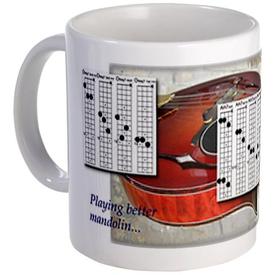« Reverse Dorian/Minor FFcP scales |
Main
| Can you trust your ears? »
 June 12, 2014 | Mandolin accompaniment--avoiding the third rail June 12, 2014 | Mandolin accompaniment--avoiding the third rail
 Rapid transit trains are powered by a semi-contiuous conductor near the tracks, often referred to as the "third rail." It's a great metaphor for things to avoid, necessary for getting somewhere, but something you absolutely don't want to touch. Rapid transit trains are powered by a semi-contiuous conductor near the tracks, often referred to as the "third rail." It's a great metaphor for things to avoid, necessary for getting somewhere, but something you absolutely don't want to touch.
When mandolinists play an accompaniment role with other percussive instruments like guitar or piano, there are intrinsic dangers cluttering up the ensemble rhythmically. A general rule of acoustics is the highest (in pitch) instrument will always be identified as the offender in a conflict. When you clash with a guitar, mandolin loses.
Clacky Clacky. Swing division is rhythmically defined intuitively. Fast and hard, slow and relaxed, and everything in between, the best bands demonstrate an uncanny uniformity when all the players are feeling the same groove. Think Count Basie, how unique it is for a section of wind instruments can play with a feel that both defies and supports the solid pulse of the rhythm section. When the bass and drums lay it all down, it's sparseness that gives room for groove. Conversely the clutter of two rhythm fret musicians in a trio or quartet can completely destroy it.

It's generally not the downstroke that is the culprit; the syncopated upswing of the pick and when it lands. Swing ranges from dotted 8th note to triplet, and 95% of the time somewhere in between, and the placement of the upstroke defines the feel. When two fret musicians give space to this, it lessens conflict. Stay out of the way and advice to the mandolinist, you have the heavier burden of not being pegged as the offender when strumming gets ragged. Watch the upstroke!
Four to a bar. Think Django Reinhardt and gypsy jazz and how the groove is laid. It's almost always the role of one instrument, a rhythm guitar that does nothing but hard "chops" on the downbeat. Done well, it's defining and absent drums, it plays the critical role of the ensemble's "clock." It's a lot easier for a mandolin to join on the downbeat in this situation, but it still must be perfect. Don't feel obligated to play all the time as a song can be so much richer when you vary the texture of the instrumentation. Sit out some choruses.
Meat in the strings. Harmonically, the mandolin comps better in the lower three courses of strings. There's color in the 1st string for a chord extension, but it's not always easy to agree with the variations of another rhythm instrument, especially piano. If she's varying it with a A7#9 and you slip in an A7b9, it muddies the harmony, so it's often better to leave out the 1st string in your voicing. Acquire a good 3-note chord vocabulary.

Texture. Sometimes we just get too busy. We think we have to contribute energy to the group the whole time. Sit out some of the time. It gives variety when you do, and makes your playing even more meaningful when you do. Use 2-note chords, half-note melodic counter-melody, or a sustained tremolo occasionally. It doesn't always have to be chop, chop, chop.
A large majority of mandolinists come from a guitar background and are guilty of approaching it as a little mandolin. Don't make this mistake!
Further
Five part series on 3-note vamp chords complete
Guitar to mandolin
Plays Well With Others
Ensemble Sensitivity: Corps playing
The Fight for Sonic Turf
Posted by Ted at June 12, 2014 7:16 AM

Disclaimer: In the 'Information Age' of the 21st Century,
any fool with a computer, a modem, and an idea can
become a self-professed 'expert." This site does not
come equipped with 'discernment.'
|



